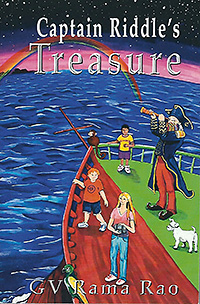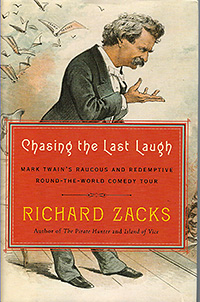
Books

 “Captain Riddle’s Treasure” (224 pages, $16.95); by G.V. Rama Rao; published by Savant Books and Publications; (www.savantbooksandpublications.com)
“Captain Riddle’s Treasure” (224 pages, $16.95); by G.V. Rama Rao; published by Savant Books and Publications; (www.savantbooksandpublications.com)
Leprechauns. Fire-spewing dragon. Godzilla. King Midas. Knight on elephant. Night fairy. These and many more unusual encounters are experienced by three gifted children who have been banished by the night fairy to a desolate island. Ruth, Zach and Tim are stuck in a timeline on a one-of-a-kind ship trying to find their way back home. Their crime? For frequently fighting with their siblings. But the trio uses amazing riddle-solving skills to solve their predicament. Though the book is written for third-graders and above, it will draw in the young and old alike. For that, our kudos go to the Central Florida (Windermere) author, a retired commander of the Indian navy, for drawing from his vast experiences at sea to pen an enjoyable, exciting, intriguing and educational book. And best of all, it is a light, fun and quick read. Rama Rao, a mariner who commanded 15 ships, is no stranger to writing. He is also the author of “The Colonel’s Last Wicket,” “The Good Boy,” “The Incomplete Man” and “The Odd Ways of Gods.”
 “Chasing the Last Laugh” (452 pages, $30) by Richard Zacks; published by Doubleday (www.doubleday.com)
“Chasing the Last Laugh” (452 pages, $30) by Richard Zacks; published by Doubleday (www.doubleday.com)
He visited countries such as England, France, Italy, Germany, Austria, Switzerland, Sweden, Australia, New Zealand and South Africa. But it is “the only foreign land that I ever daydream about or deeply long to see again,” wrote Mark Twain years after a speaking but ill-ridden tour of Asia. India fascinated the Hannibal, Missouri, native for several reasons, according to the author of this book. Zacks notes that the American author was captivated by the “eclectic, brazen color-charged chaos of India, of ashes-splashed naked holy men, of cinnamon-tinted women twirled in gaudy gauze, of cows ruling corners, of monkeys enshrined in temples, of corpses devoured by cultures, of fakirs running freak shows, of jeweled maharajahs aboard even more bejeweled elephants, of harems ported in swaying palanquins …” The year was 1896 and Twain visited Bombay, Baroda, Calcutta, Darjeeling, Benares, Jaipur, Agra, and the Himalayas. Lest one forgets, Zacks reminds the reader that though perceived as a passionate anti-imperialist, Twain was often praiseful of the British governing India, “the best kind of people for colonizing the globe.” Which sort of puts a slight damper on his entire visit, in my opinion.